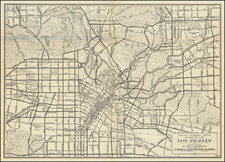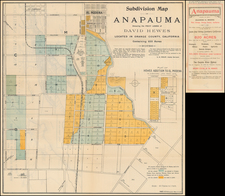Tweedy Park Subdivision -- LA's 1920s Real Estate Boom
Fine map of the Los Angeles Basin, promoting "The Pivotal Point," the Tweedy Park subdvision of South Gate, which was marketed and sold in September 1923, during one of LA's massive land booms.
The pictorial style birdseye view is centered on Watts, and illustrates the area being offered for sale, immediately between the booming metropolitan Los Angeles and its "industrial district" to the south, including Terminal Island, Compton and Willmington. The expanse of LA is shown beyond Tweedy Park, looking northward to the San Gabriel Mountains and west to the Coast. On the verso is a detailed plan of the Tweedy Park subdivision.
Tweedy Park subdivision was part of the 1920s town of South Gate. The land on which South Gate was founded was once part of the Rancho San Antonio, owned for decades in the 19th century by the prominent Lugo family. In 1852, a wagon train of settlers led by Micajah Johnson (who was briefly ranch foreman for William Workman), arrived from Arkansas and established what became El Monte. Robert and Mary Tweedy wer a part of the emigrant party. The Tweedys bought 2,000 acres of the Lugo family’s Rancho San Antonio, west of Rivera, and much of that was later acquired by Michael Cudahy, who was already owner of much of what was formerly the Nadeau Ranch.
Among the portions of Cudahy’s property was what was known as South Gate Gardens. In 1920, the City of South Gate was incorporated. Almost immediately, Wilson, McDevitt and Company began developing Tweedy Park. In the then-booming Los Angeles market, the Tweedy Park project did not take long to fully market and sell in the late summer and afterward in 1923. On September 16, 1923, an advertisement in the Los Angeles Times called “Tweedy Park News” promoted the grand opening. The land apparently sold out immediately.
Rarity
The map is apparently a unique survival.
We find no record of the map in OCLC or elsewhere.













![San Bernardino County [and:] Southwest Portion of San Bernardino County](https://storage.googleapis.com/raremaps/img/small/96727.jpg)
![[Los Angeles, Santa Barbara & Central Coast ] Amer. Sep. No. 52 Partie De La Nouvle. Californie](https://storage.googleapis.com/raremaps/img/small/93539.jpg)
![[Southern California Citrus Fair Promotional Broadside] Riverside Exhibit / Removed From Riverside Cal. to Armory Hall, Los Angles, Open Day & Eve'ng from Feb 29 to March 6th 1888](https://storage.googleapis.com/raremaps/img/small/74529.jpg)
